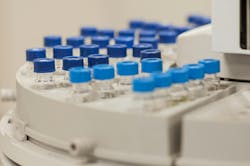Mass spectrometry’s place in the clinical lab: How it’s used and why
A critical technique in clinical laboratory testing, mass spectrometry (MS) involves, at its core, examining a mass of molecules. Think of mass spectrometry as a tiny scale for molecules. Yet, unlike the scale in your bathroom, it doesn’t measure actual weight (which is influenced by gravity) but instead identifies the mass of a molecule based on its mass-to-charge ratio (m/z) after one or more molecules have been electrically charged (or turned into ions).
Why is assessing the mass of molecules important? Because it helps to carefully characterize those molecules, measure them and, in some cases, discover unknown ones.
Mass spectrometry can be like searching for a needle in a haystack. As an example, laboratorians routinely measure compounds in the blood — both small molecules, like drugs or steroids, or large molecules, like proteins or lipids — that exist in part-per-billion or even part-per-trillion levels. Imagine a machine that can help identify if a patient’s specimen contains both a prescribed opioid, which may be highly beneficial to the patient for pain relief, and an illicit fentanyl opioid, which can be lethal, through all that noise. Or a specimen that has tiny quantities of molecules of the amyloid brain protein circulating in the blood in the earliest stages of Alzheimer’s disease. That’s the power of mass spectrometry.
Mass spectrometry evaluates the quantity of molecules that make up a substance and has been found to have improved specificity and sensitivity when compared to traditional techniques in several applications where precise measurement of molecules is necessary. It can be used across a range of specimen types: serum, plasma, blood spots, even breath!
Mass spectrometry involves many different techniques. One advanced version of this testing is called tandem mass spectrometry. This technique involves two separate stages of mass analysis that a lab professional can use for comparison, with two levels of mass filtering. The first level filters based on the mass of the molecule itself. The molecule is then broken apart by collision with high-pressure gas, and the second level of mass filtering occurs on the fragments of this molecule. This can be helpful when used to decipher relationships among ions in a mass spectrum.1
Because it involves two analyzers, tandem mass spectrometry may provide more specificity than mass spectrometry.2 The results have many analytical implications when interpreted, spanning everything from drug monitoring to brain health testing. Another commonly used form of mass spectrometry is liquid chromatography (LC), which involves separating compounds in a sample prior to analysis.
Despite its advantages, several challenges prevent broad implementations of this technique, despite the continued emergence of clinical applications for the technology.3
How mass spectrometry is utilized in a clinical laboratory
Typically, tests that utilize mass spectrometry technology (or liquid chromatography coupled with mass spectrometry, or LC-MS, are highly advanced tests that require specialized skill and technology to perform. In addition, sample preparation before analysis can be complex and time-consuming because of the number of variables that can impact results.7
However, mass spectrometry technology has several specific use cases with the potential to empower the development of clinical diagnostics and precision medicines. There are many different ways a clinical lab can use this technology, but three specific ways we at Quest are using mass spectrometry is in prescription drug monitoring, “Forever Chemicals” PFAS blood testing and for neurology testing related to risk assessment for Alzheimer’s disease.
Last year, Quest launched a confirmatory testing service for novel psychoactive substances (NPS). The panel tests for 88 compounds and covers a broad array of drug classes, such as designer opioids, designer benzodiazepines, designer stimulants, fentanyl analogs, synthetic cannabinoids, and other illicit additives.4
NPS are versions of established prescription and illicit drugs that are routinely chemically altered to enhance drug effects and evade tracking by law enforcement. As their chemical composition frequently evolves, conventional point-of-care and laboratory test methods may fail to detect NPS, increasing risks for individual patients and challenging efforts to understand their long-term health effects or prevalence in communities.
Our panel uses liquid chromatography with advanced tandem mass spectrometry–based testing to establish NPS misuse. Specifically, a team of toxicologists, medical experts and data analysts will periodically review and update the panel to include the most relevant and prevalent substances present in communities. This way, the panel will continue to address the changing drug epidemic.
Mass spectrometry’s place in the science behind Alzheimer’s disease
Alzheimer's disease is the most prevalent dementia, affecting nearly 7 million Americans.8 Diagnosis of the disease has traditionally involved cerebrospinal fluid and PET imaging tests, which can be specialist-dependent and expensive. In recent years, blood tests have changed how physicians approach assessing risk and diagnosing this disease. Certain blood tests, which measure biomarkers like p-tau217 or 181, or amyloid-beta proteins, rely on mass spectrometry to provide the sensitivity and specificity necessary to give patients insights on their risk of developing Alzheimer's disease.
Our AD-Detect™ blood test portfolio has several tests that leverage this technology in patients with cognitive impairment. The increased sensitivity and specificity are needed for highly precise amyloid-beta testing, which evaluates a ratio of proteins in the brain that also circulate in the blood stream. When monitoring changes over time, these tests can also look at a patient’s changing risk or disease progression.9
While PET scans have traditionally evaluated patients for Alzheimer's disease, new blood tests offer the potential for primary care physicians as well as specialists to identify people at risk even before symptoms manifest.5 In fact, research shows these highly sensitive mass spectrometry tests could help reduce PET brain scan evaluations by about 40% — identifying lower risk patients who would have otherwise been dependent on this expensive and specialist-dependent form of imaging.5 The findings show immense promise in mass spectrometry, and can potentially lead to cost savings if blood tests become able to prevent a need for further tests and care.
Hurdles to a larger rollout of mass spectrometry
Yet, there are some drawbacks preventing the widespread adoption of this technology in clinical testing. Employing mass spectrometry requires a technical specialist with a skill set that can be difficult and time-consuming to teach.3 Given the lab industry has been plagued, since the COVID-19 pandemic, with issues of staffing shortages and burnout,6 it may be difficult to find specialists capable of this complex work with the certifications needed to perform clinical assays. Mass spectrometry requires analyzing complex algorithms for data processing, quantification, and identification of proteins. For some labs, identifying and employing these specialists may also be cost-prohibitive.
The future of mass spectrometry adoption
The evolution of mass spectrometry within a clinical laboratory setting has, and will, continue to grow. More frequently, the advantages of mass spectrometry-based applications have been realized in laboratory medicine.3 Furthermore, the clinical lab industry has started to see a shift towards personalized medicine that is unlikely to stop. From oncology to drug monitoring, mass spectrometry–based approaches are influencing the ways labs deliver testing and results reporting.
Barriers like costs and training may hinder the widespread adoption of this technology, but the superior specificity and sensitivity offered for this type of testing may make addressing these hurdles well worth it for labs. By expanding its use, labs can continue to address patient needs faster, bringing them the insights needed to deliver effective care.
References
1. Tandem Mass Spectrometry. Sciencedirect.com. Accessed June 28, 2024. https://www.sciencedirect.com/topics/nursing-and-health-professions/tandem-mass-spectrometry#.
2. Pitt JJ. Principles and applications of liquid chromatography-mass spectrometry in clinical biochemistry. Clin Biochem Rev. 2009;30(1):19-34.
3. Thomas SN, French D, Jannetto PJ, Rappold BA, Clarke WA. Liquid chromatography-tandem mass spectrometry for clinical diagnostics. Nat Rev Methods Primers. 2022;2(1):96. doi:10.1038/s43586-022-00175-x.
4. Quest diagnostics launches new 88-compound novel psychoactive substance test panel. Quest Diagnostics Newsroom. Published December 19, 2023. Accessed June 28, 2024. https://newsroom.questdiagnostics.com/2023-12-19-Quest-Diagnostics-Launches-New-88-Compound-Novel-Psychoactive-Substance-Test-Panel.
5. Study in frontiers in neurology affirms amyloid blood test can help identify patients who may forgo imaging evaluation for Alzheimer’s disease. Quest Diagnostics Newsroom. Published March 26, 2024. Accessed June 28, 2024. https://newsroom.questdiagnostics.com/2024-03-26-Study-in-Frontiers-in-Neurology-Affirms-Amyloid-Blood-Test-Can-Help-Identify-Patients-Who-May-Forgo-Imaging-Evaluation-for-Alzheimers-Disease.
6. Webmaster A. Clinical laboratory personnel shortage. ASCLS. Published December 21, 2012. Accessed June 28, 2024. https://ascls.org/workforce/.
7. Hess S. Sample Preparation Guide for Mass Spectrometry–Based Proteomics. LCGC Supplements. 2013;11(3):12-17. Available from: https://www.chromatographyonline.com/view/sample-preparation-guide-mass-spectrometry-based-proteomics-0.
8. Alzheimer’s Disease Facts and Figures. Alz.org. Accessed June 28, 2024. https://www.alz.org/alzheimers-dementia/facts-figures.
9. Physicians foresee an Alzheimer’s Disease treatment revolution supported by advanced testing tools, new quest diagnostics report finds. Quest Diagnostics Newsroom. Published May 2, 2022. Accessed June 28, 2024. https://newsroom.questdiagnostics.com/2022-05-02-Physicians-Foresee-an-Alzheimers-Disease-Treatment-Revolution-Supported-by-Advanced-Testing-Tools,-New-Quest-Diagnostics-Report-Finds.
About the Author

Darren Weber
is an Associate Scientific Director in the R&D Mass Spectrometry department at Quest Diagnostics-Nichols Institute in San Juan Capistrano, California. Darren is primarily responsible for the development of high-throughput quantitative mass spectrometry-based proteomic assays for the clinical laboratory, with an emphasis on Alzheimer’s disease and other neurodegenerative disorders. Prior to joining Quest Diagnostics, Darren was a member of the UC Davis Proteomics Core where he gained extensive experience in protein sample preparation and high-resolution mass spectrometry.
